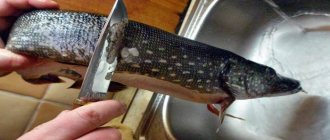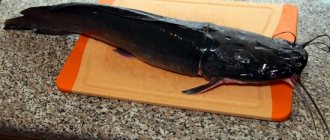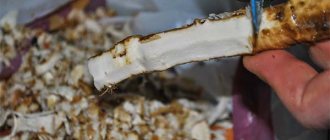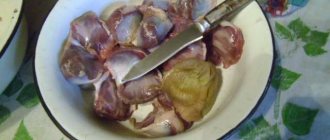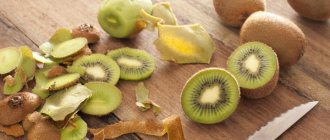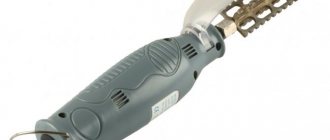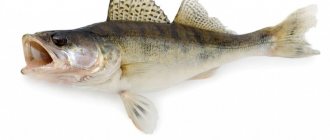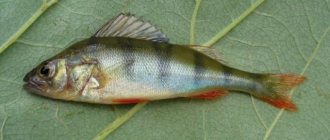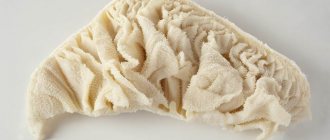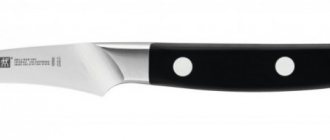07/02/2021 598 Pisces
Author: Alexander
It is necessary to clean the pike with a wide and sharp knife, otherwise you will not be able to get a truly perfect piece. It is important not only to prepare the product for further heat treatment, but also to correctly remove the entrails and remove the skin without damaging the fillet.
[Hide]
With a knife
A simple and common way to clean a pike is to use a sharp knife with a blade length of up to 40 cm. This allows you to cut the fish as quickly as possible. The video clearly shows a technique that is ideal for ordinary people, housewives and experienced fishing enthusiasts.
You can use a special tool. The scales do not scatter on the floor or on the kitchen furniture. Cleaning with a knife is suitable for this; this is the best solution. This takes up to 30 minutes, less time than other processing methods.
If you do not wash off the mucus after cutting, it will ruin the taste of the pike meat.
One expert prefers to clean frozen pike with a fork:
- The carcass is cut into 2 parts (sides), for this the carcass is placed on the table. Pass over the skin with a fork; it removes large scales well;
- Small scales can be removed with boiling water or a sharpened kitchen knife.
Boiling water spoils the skin, so cutting into fillets for salting is not suitable. Rather than doing this with a knife, when first the scales are removed, then gutting, removing the entrails, gills, and head. Don’t forget about bile; with the release of bile, the meat will be saturated with bitterness.
Gourmets prefer to keep the skin intact. The carcass is suitable for all types of dishes, especially for frying and stewing in the oven.
Pike weight reaches 30 kg, dimensions – up to 1.5 m
Is it difficult to clean a pike?
Pike belongs to freshwater fish from the pike family. The length can reach 150 cm, and the weight can range from 2 to 35 kg. The meat is quite nutritious and low in calories. Fish has a less rich and expressive taste and is used to prepare a variety of dishes.
Treat yourself, your loved ones or guests with stuffed pike, aromatic fish soup or fried steaks that will please even the pickiest gourmet. But despite the excellent taste, few people know how to clean pike, which greatly complicates the process of preparing it. It's actually not difficult to learn. To do this, you need to be patient and follow the tips below.
The uniqueness of pike is that its meat contains almost no fat (maximum 2%) and is rich in protein. But the unprocessed predator has two drawbacks: a lot of bones, as well as a specific smell. These unpleasant characteristics make this delicacy unpopular in home cooking. However, these disadvantages can be turned into advantages that allow you to prepare a delicious holiday dinner.
Pike always smell like silt, and the larger the trophy, the more noticeable the smell. You can reduce it by soaking the fish in milk before cooking. Whole baked pike is a royal dish, and if you don’t want to spoil it, there’s no point in skimping on milk. It takes several hours to soak the fish in milk. It is better to do this after cleaning.
Boiling water and lemon
It all depends on what kind of pike you have in front of you - live, frozen or chilled carcass. From 3 states, choose convenient methods for cleaning: live or chilled are easy to process.
It is easier to speed up the cleaning of a frozen semi-finished product when the body is doused with boiling water. To remove musty smells or swamps, use the juice of squeezed fresh lemon. Mucus is removed with running warm water. An approximate instruction for processing river specimens looks like this.
- Pike scales are easily and quickly separated when the fish is freshly caught. The scaly layer comes off easily if you rub the fish with lemon and then pour boiling water over it.
- Rubber gloves are used to protect hands; gloves made of cotton or cotton material are put on top. This allows you to protect your palms and fingers from cuts, bones, scales, and prevent sliding along the body.
- To remove the residual musty river and lake odor, experts suggest first washing the body of mucus and dirt, and then performing additional processing. The pike is generously doused on both sides with a warm solution of water and salt, freshly squeezed lemon juice and water are used (50/50).
- If the fish is frozen. Pour boiling water over the pike on each side until the ice disappears. After which the procedure is repeated to remove surface mucus. Select a pan or basin to suit the size of the carcass. Leave the carcasses soaked, add vinegar and lemon juice to warm water.
- Rubbing the sides of the body with table salt helps remove remaining mucus. After 30 minutes, it is suggested to thoroughly wash the peritoneum from any remaining salt. After removing the intestines and bile, the black film is removed from the inside. Do this in the sink with a weak stream of warm or hot water for up to 5 minutes. The final step is to blot the body with waffle paper towels.
Preparatory stage
Before starting work, it is necessary to carry out a number of preparatory procedures :
- First of all, prepare your workplace and tools.
- An important point is the use of gloves. Hands need to be protected from wounds.
- Pike has many dense scales. Bone plates may fly apart during cleaning. You should put the dishes away and cover them with a cloth.
- You will need a large basin filled with cold water.
- When working, it is better to use a cutting board made of plastic or glass. The wooden board will be saturated with the smell of fish.
- Place a napkin or towel under the board. This will prevent the board from sliding on the table surface.
- It is preferable to use a device like a grater with a container. Or a knife with a large blade will do. They cut the fish. To clean the scales you will need a smaller knife.
- After washing the pike with water, treat its tail with coarse salt. The fish will become less slippery.
- You should not try to stick your hand into the pike's open mouth. Many sharp teeth can easily hurt.
- Be careful with the gills. The organs of water respiration have large spines.
- Cleaning fresh pike is easier than cleaning pike that has been sitting for a long time. Proceed to cleaning frozen fish after waiting for the scales and skin to thaw.
- The presence of the river smell discourages those who want to feast on it. To solve the problem, it is useful to use lemon juice.
Karcher
The simplest and easiest procedure is to use a KARCHER mini car wash. The carcasses are laid out on a wide cutting board; instead of special tools (knife, grater, fork, scraper), they hold a hose in their hands, and the nozzle is directed at the carcasses. To properly remove scales, the body is placed along the board, the tails are clamped with a foot or crossbar. Turn on the washer and direct the nozzle away from the tail against the opening of the scales. Movements are made smooth, passes are made across the width of the body. The angle between the nozzle and the board is no more than 15 degrees.
Hold tightly so that the fish is not thrown aside by the flow of water. The carcass is cleaned of scales with a powerful jet. In addition to pike, other varieties of river and sea fish are processed in the same way: perch, pike perch, silver carp, carp, carp. The main convenience is that with a KARCHER sink, cleaning one side occurs quickly, taking 2-3 minutes at most. Then the body is turned over on its 2nd side and the process is repeated. So, in 4-5 minutes the fish is completely cleared of all scales and mucus.
Gutting
The pike is gutted after cleaning the scales. First, the films should be removed, for which the pike is cut. To do this, the belly is cut, the head is cut, and the entrails are pulled out.
Important! When gutting, carefully remove the entrails so as not to damage the bile, otherwise the bitterness will spoil the meat. The esophagus is pulled out with the gills, leaving the head. The white film that runs along the belly (swim bladder) is removed.
Next, the head is cut off with a knife, it should be removed, after which they begin cutting up the carcass. It all depends on what the fish meat is used for: minced meat, fillet, steak, pieces, filling the cavity with vegetables, herbs, rice, and other products.
Photo gallery
Cleaning the hide
Incision to remove viscera
Cleaning scales with a wire brush
Cleaned pike
Removed gills
Step-by-step preparation of fillets
Removing scales with a knife
Removing the head
Clearing mucus
Easy and simple ways to clean mucus from pike - rinsing with water, rubbing with salt or soda. Cleaning efficiency is achieved by intensively washing the carcasses with a warm, hot stream of water.
Where live fish are caught affects the appearance of the pike. The lake specimen is covered with debris and a thin layer of mucus. The river specimen contains more mucus.
An alternative to removing mucus is rubbing the sides with salt. After which, thoroughly rinse everything off with a stream of warm or hot water (30-50 0C) for up to 3 minutes. The process is completed by wiping and blotting the carcass with paper or waffle towels.
Steak cutting
The fillet is suitable for 100 dishes, from various types of frying with vegetables to 10 types of fish soup. An interesting detail, useful for both babies and adults, including pregnant women and mothers who are breastfeeding.
Cut the fish on a board other than a wooden one. Wood absorbs various odors and transmits them to the fish. The carcass is filleted with a sharp knife, then everything must be washed with warm water.
Fresh pike meat is dietary, it is rich in active vitamins A, B, PP, E, C. Fresh fish contains 10 microelements useful to people, including: zinc, copper, iodine, iron, cobalt, fluorine, nickel, molybdenum, chromium , manganese, others
How to choose the right fish
How to cook delicious pike? The best dishes are prepared from freshly caught fish that meet these criteria:
- Smell. It should be neutral or with a slight river shade. The presence of an oil smell indicates that the carcass was rubbed for longer storage. If it smells like chlorine or ammonia, avoid purchasing it completely.
- Appearance. The meat looks juicy, not dry or dehydrated. There are no spots of strange shades on the skin. The color is bright and uniform.
- Gills. They should be bright red. A dark shade or an unpleasant odor means the fish is not fresh.
- Eyes. In fresh fish they are transparent and convex. If the eyes are red and cloudy, it means that this product has been lying on the counter for a long time.
Filleting
The filleting procedure begins from the base - the head. First, cuts are made to comfortably hold the pike. The carcass is fixed, the fish is placed on its left side, and the cutting of the body continues to the ridge. When the knife reaches the ribs, stop slicing. The fish is divided into 2 separate parts from head to tail.
Hold the knife correctly - parallel to the ribs. The resulting 2 halves are placed skin side down, thus carefully separating the meat fillet with a knife from the tail part. Remove visible large and small bones with tweezers. At the last stage, carefully remove the skin, pick it up with kitchen tweezers, and use ordinary pliers.
For minced meat
They grind the meat in a meat grinder - properly prepared minced meat is suitable for cutlets. Initially, large bones (spine) are removed. The vertebral column of the pike is strong and hard.
In small fish, the spine is not removed for minced meat.
Cut medium or large-sized fresh fish to prepare delicious minced meat as follows:
- It is laid out along the cutting board.
- Using the blade of a sharp knife, make cuts parallel to the spine. The fillet is cut to the tail, after which the tail part is cut off and thrown away. The knife is used in such a way as to quickly process the body along the incised ridge.
- In the usual way, you need to cut the fillet from each side of the fish.
- The middle, along with the spine, is removed in order to use it for cooking and frying fish soup.
- Remove bones to use clean meat for cutlets. To remove the skin, otherwise when grinding the fillet into minced meat, the bones crumble, this is unfavorably felt in the finished cutlet. The fillet is processed in a meat grinder using the finest grill. To better chop the seeds, do it at least 2 times.
Preparing the stuffing filling
The taste of the finished dish largely depends on how well the filling was prepared. First of all, the meat separated from the bones must be twisted twice in a meat grinder. Moreover, after the first time, the device will need to be disassembled and the accumulated bones removed. When the meat is twisted for the second time, add fried onions and carrots, as well as a raw egg, salt and pepper to taste.
If the filling does not seem enough, you can add a couple of slices of bread soaked in milk to the minced meat. It needs to be rubbed well with your hands and mixed so that the mass turns out to be a homogeneous consistency.
For frying fillets
There are many bones on the body, both massive (spine) and medium and small.
Fresh boneless fish fillets are prepared step by step:
- Cut the fillet along the length of the body.
- Turn the carcass over and cut off the fillets on both sides.
- The remains of the ridge and tail are cut into pieces and placed in a bowl or basin.
- The fillet is separated from the ribs. Thin bones are removed with a sharp knife, which, if processed incorrectly, leads to loss of the meat part of the product.
- All fins are removed.
- The flesh with the bone is felt above the symbolic line of the ribs, and 2 even cuts are made along the body.
- Strips with bone are separated with a knife and cut into fillets.
- The remaining bones are removed with tweezers. Smooth layers of fish pulp are obtained without all the bones.
- The body is cut off and the skin is removed.
- The fillet is cut into equal portions and prepared for any dish according to variants of the selected recipes, taking into account the use of ingredients and methods of preparing dishes.
